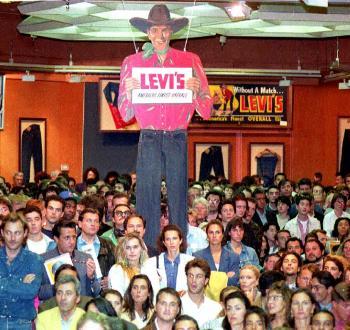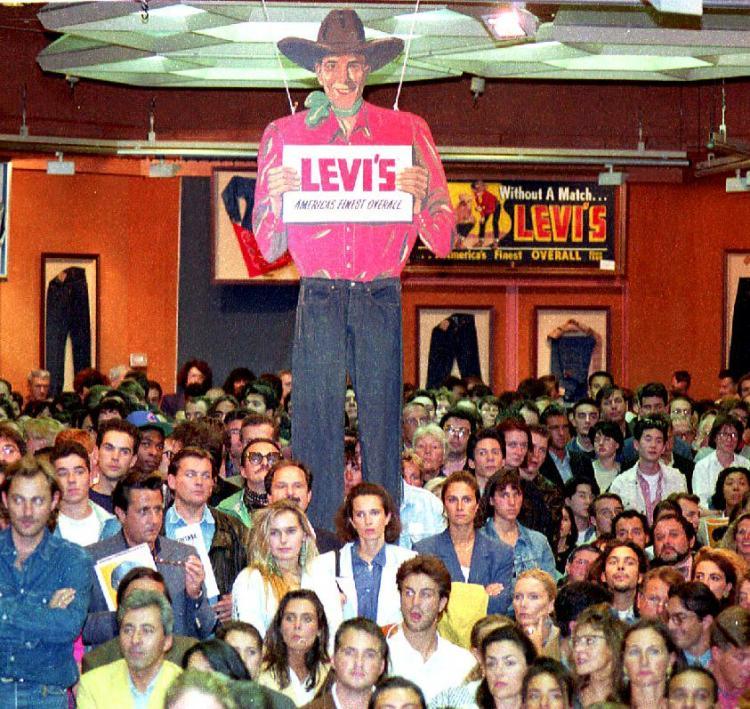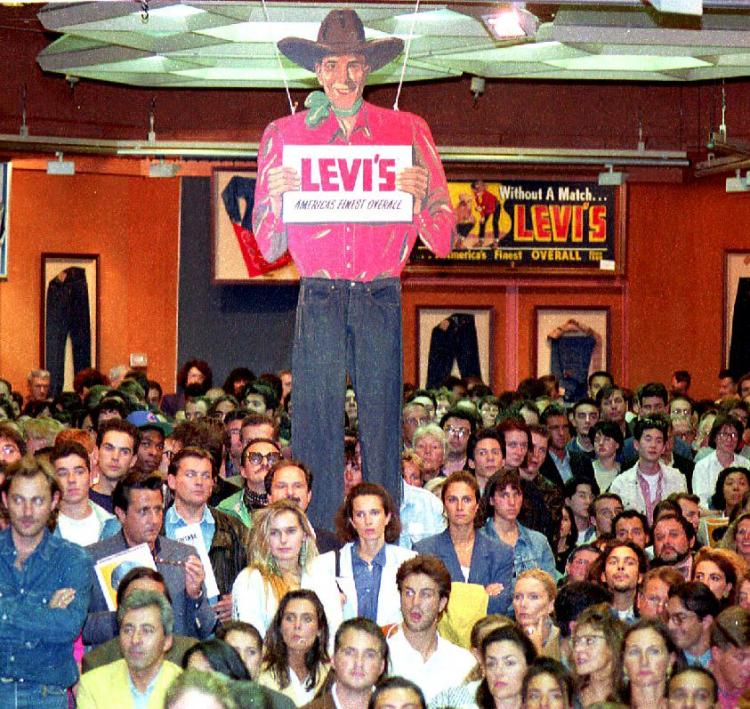The first brand of jeans that comes to mind is also the oldest: Levi’s. From the 1950s to today, jeans have come in countless different styles and washes, changing right along with social trends.
But why are jeans so popular today? Because they are comfortable, sturdy, and they basically go with everything. In other words, jeans have become the most recognizable clothing item of our time.
But jeans haven’t always been so fashionable, being used primarily as work clothes for miners, sailors, and cowboys. Let’s delve even deeper in time to learn the history of what is now known as denim.
Long before Levis Strauss popularized denim, in the 16th century, India exported dungaree, a fabric made of heavy, coarse cotton that was colored indigo. It was sold to Portuguese sailors who used it to make the sails for their boats. The fabric was also sewn into clothes, mainly worn by the poor.
During the same period, in the small Italian village of Chieri, close to Turin, the fabric that was to become denim was being sold. The naval fleet of Genoa, Italy, used it to make sturdy pants for its sailors that could be worn both dry and wet, and that could be easily rolled up.
These pants were washed in the sea in a net that was hung at the back of the ship. Interestingly enough, it was the contact with the sea salt that gradually faded the blue color of the pants. The name “blue jeans” is a derivative of “blue of Genoa.” The fabric, however, came from the city of Nimes in France.
So what makes the fabric so unique? The key lies in its diagonal weaving, which is popularly called the twill. Blue threads were weaved with white ones, which became characteristic of the “serge de Nîmes.” “Serge de Nîmes” has since been replaced by the shorter “denim.”
It was over 200 years later, in 1829, that Levi Strauss was born in Bavaria, Germany. Several years later, he emigrated to New York where he joined his older brothers who owned a dry goods business. In 1853, he became an American citizen and decided to open a business in San Francisco, which at the time was still in the midst of the gold rush.
Levi Strauss planned to sell buttons, scissors, bolts, and rough fabric to the miners to cover their equipment or to make tents. But he was surprised to see that few people wanted to buy his products.
On the other hand, the miners complained that they did not have pants that were rough enough to withstand the mud and filth. He then came up with the idea to make overalls from rough cotton. Although a good idea, the fabric was too rough and it was not comfortable. Despite this obstacle, his business grew and Strauss then ordered the “serge de Nîmes,” or denim, which was both sturdy and comfortable.
Denim jeans became very popular, but there was still a problem that tailor Jacob Davis took upon himself to solve. Mr. Davis was, in fact, one of Levi Strauss’s customers—buying cotton fabrics and other dressmaking accessories. The miners took their pants to Davis so he could readjust the pockets, which frequently tore.
Davis then had the brilliant idea to reinforce the pockets with copper rivets. However, since he couldn’t afford to buy the patent for his invention, he invited Strauss to join him as his partner. In 1873, the patent to reinforce the pockets was bought and Strauss’s business, Levi Strauss & Co., started to manufacture the famous denim pants with copper rivets. The yellow and orange stitching, which has since become a characteristics of jeans, was designed to match the rivets.
Soon after, Levi invented the small red tag, which he placed on the corner of the pocket. It was the first time that a tag that was placed on the outside of clothing.
Today’s designers are busy trying to reinvent the denim jean with unique washing techniques, which include the use of pumice stone, enzymes, and acid washing. Throughout its 400 years of history, denim has been washed, torn, embroidered, beaded, studded, shortened, and stretched. Basically, it has passed through all types of fashions and designs.
But throughout all this, the basic characteristics of denim have never changed. After all, why would one want to change a classic?
But why are jeans so popular today? Because they are comfortable, sturdy, and they basically go with everything. In other words, jeans have become the most recognizable clothing item of our time.
But jeans haven’t always been so fashionable, being used primarily as work clothes for miners, sailors, and cowboys. Let’s delve even deeper in time to learn the history of what is now known as denim.
Long before Levis Strauss popularized denim, in the 16th century, India exported dungaree, a fabric made of heavy, coarse cotton that was colored indigo. It was sold to Portuguese sailors who used it to make the sails for their boats. The fabric was also sewn into clothes, mainly worn by the poor.
During the same period, in the small Italian village of Chieri, close to Turin, the fabric that was to become denim was being sold. The naval fleet of Genoa, Italy, used it to make sturdy pants for its sailors that could be worn both dry and wet, and that could be easily rolled up.
These pants were washed in the sea in a net that was hung at the back of the ship. Interestingly enough, it was the contact with the sea salt that gradually faded the blue color of the pants. The name “blue jeans” is a derivative of “blue of Genoa.” The fabric, however, came from the city of Nimes in France.
So what makes the fabric so unique? The key lies in its diagonal weaving, which is popularly called the twill. Blue threads were weaved with white ones, which became characteristic of the “serge de Nîmes.” “Serge de Nîmes” has since been replaced by the shorter “denim.”
It was over 200 years later, in 1829, that Levi Strauss was born in Bavaria, Germany. Several years later, he emigrated to New York where he joined his older brothers who owned a dry goods business. In 1853, he became an American citizen and decided to open a business in San Francisco, which at the time was still in the midst of the gold rush.
Levi Strauss planned to sell buttons, scissors, bolts, and rough fabric to the miners to cover their equipment or to make tents. But he was surprised to see that few people wanted to buy his products.
On the other hand, the miners complained that they did not have pants that were rough enough to withstand the mud and filth. He then came up with the idea to make overalls from rough cotton. Although a good idea, the fabric was too rough and it was not comfortable. Despite this obstacle, his business grew and Strauss then ordered the “serge de Nîmes,” or denim, which was both sturdy and comfortable.
Denim jeans became very popular, but there was still a problem that tailor Jacob Davis took upon himself to solve. Mr. Davis was, in fact, one of Levi Strauss’s customers—buying cotton fabrics and other dressmaking accessories. The miners took their pants to Davis so he could readjust the pockets, which frequently tore.
Davis then had the brilliant idea to reinforce the pockets with copper rivets. However, since he couldn’t afford to buy the patent for his invention, he invited Strauss to join him as his partner. In 1873, the patent to reinforce the pockets was bought and Strauss’s business, Levi Strauss & Co., started to manufacture the famous denim pants with copper rivets. The yellow and orange stitching, which has since become a characteristics of jeans, was designed to match the rivets.
Soon after, Levi invented the small red tag, which he placed on the corner of the pocket. It was the first time that a tag that was placed on the outside of clothing.
Today’s designers are busy trying to reinvent the denim jean with unique washing techniques, which include the use of pumice stone, enzymes, and acid washing. Throughout its 400 years of history, denim has been washed, torn, embroidered, beaded, studded, shortened, and stretched. Basically, it has passed through all types of fashions and designs.
But throughout all this, the basic characteristics of denim have never changed. After all, why would one want to change a classic?






